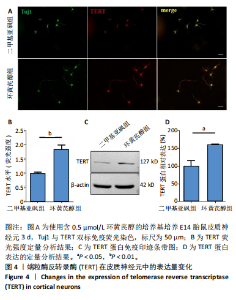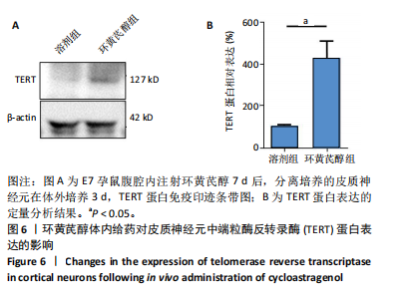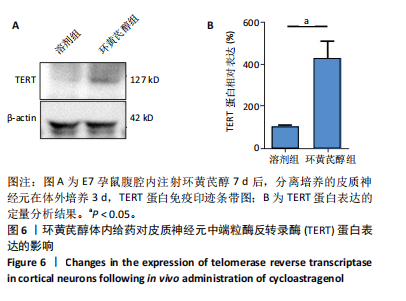Chinese Journal of Tissue Engineering Research ›› 2025, Vol. 29 ›› Issue (20): 4258-4265.doi: 10.12307/2025.694
Previous Articles Next Articles
Cycloastragenol promotes motor function recovery and cortical neuron regeneration in mice with spinal cord injury
Tao Zihan, Saijilafu
- Orthopaedic Institute, Suzhou Medical College, Soochow University, Suzhou 215031, Jiangsu Province, China
-
Received:2024-06-12Accepted:2024-08-13Online:2025-07-18Published:2024-12-20 -
Contact:Saijilafu, Professor, Doctoral supervisor, Orthopaedic Institute, Suzhou Medical College, Soochow University, Suzhou 215031, Jiangsu Province, China -
About author:Tao Zihan, Master candidate, Orthopaedic Institute, Suzhou Medical College, Soochow University, Suzhou 215031, Jiangsu Province, China -
Supported by:National Natural Science Foundation of China, No. 81772353 (to Saijilafu)
CLC Number:
Cite this article
Tao Zihan, Saijilafu. Cycloastragenol promotes motor function recovery and cortical neuron regeneration in mice with spinal cord injury [J]. Chinese Journal of Tissue Engineering Research, 2025, 29(20): 4258-4265.
share this article
Add to citation manager EndNote|Reference Manager|ProCite|BibTeX|RefWorks

2.1 实验动物数量分析 实验选用ICR小鼠18只,均进入结果分析。 2.2 BMS运动功能评分 造模后,各组小鼠BMS运动功能评分均为0分,小鼠后肢完全丧失运动功能,各组无统计学差异。给药4周后,环黄芪醇组小鼠运动功能逐步恢复。自给药4周起,环黄芪醇组小鼠 BMS运动功能评分显著优于溶剂组(P < 0.000 1),在给药12周时,小鼠一侧后腿实现了灵活运动,而另一侧后腿的踝关节也展现出了较强的活动能力,说明环黄芪醇能够显著改善脊髓损伤小鼠的肢体运动功能,见图1。 2.3 环黄芪醇在体外对神经元活力的影响 为了确定环黄芪醇对体外培养的皮质神经元有无潜在的细胞毒性,对细胞进行活死染色,结果显示用0.5 μmol/L环黄芪醇处理皮质神经元3 d,二甲基亚砜组与环黄芪醇组的存活细胞无明显差异,表明环黄芪醇不会导致额外的神经元死亡,见图2。 2.4 环黄芪醇在体外给药对皮质神经元的影响 前期研究证实,0.5 μmol/L环黄芪醇能够促进感觉神经元的轴突再生,但是该剂量对于皮质神经元的影响仍是未知[27]。Tuj 1(β-tubulinⅢ)是一种神经元特异性的细胞标记物,通常用于标记早期的神经元前体细胞和成熟神经元中的微管蛋白,可以跟踪神经元的形成和轴突生长[30-31]。神经元轴突生长是神经修复和再生的关键过程。受损的神经元可以通过重新生长轴突从而恢复功能性连接,以实现神经系统的修复和功能恢复[32]。在体外研究中,使用含0.5 μmol/L环黄芪醇的培养基培养E14胎鼠皮质神经元3 d后,对所得神经元进行Tuj1免疫荧光染色并测量轴突长度,发现0.5 μmol/L环黄芪醇组的神经元轴突长度平均值达到约188 μm,而二甲基亚砜组神经元轴突长度平均值约123 μm,两组轴突长度差异有显著性意义(图3A-C)。 随机统计Tuj1阳性细胞的数量,结果显示两组皮质神经元的存活无显著差异(图3D)。 2.5 环黄芪醇体外给药对皮质神经元中TERT表达的影响 已有研究表明,环黄芪醇能够上调周围神经系统背根神经节中TERT的表达,进一步激活其内在轴突生长能力,并参与外周感觉神经轴突再生的调节[25],但TERT在中枢神经系统中是否能够继续发挥促进轴突再生的作用仍是未知。在体外用含0.5 μmol/L环黄芪醇的培养基培养E14"


胎鼠大脑皮质神经元3 d后,采用细胞免疫荧光染色双标法检测Tuj1、TERT 蛋白表达。实验结果表明,环黄芪醇组皮质神经元中 TERT的荧光强度高于二甲基亚砜组(图4A,B) (P < 0.01)。同时,蛋白免疫印迹检测结果显示,环黄芪醇组皮质神经元中 TERT蛋白的表达量高于二甲基亚砜组(图4C,D) (P < 0.05),结果提示皮质神经元的轴突生长与TERT的表达升高有关。 2.6 环黄芪醇在体内给药对皮质神经元的影响 对E7孕鼠腹腔注射20 mg/kg环黄芪醇7 d后,分离皮质神经元体外培养3 d,Tuj1免疫荧光染色结果显示,环黄芪醇组的神经元轴突长度平均值达到约400 μm,而溶剂组仅为"

| [1] GORDON EM, CHAUVIN RJ, VAN AN, et al. A somato-cognitive action network alternates with effector regions in motor cortex. Nature. 2023;617(7960):351-359. [2] DE CARVALHO M, SWASH M. Upper and lower motor neuron neurophysiology and motor control. Handb Clin Neurol. 2023;195:17-29. [3] INOUE R, NISHIMUNE H. Neuronal Plasticity and Age-Related Functional Decline in the Motor Cortex. Cells. 2023;12(17):2142. [4] YU Y, ZHOU L, YANG Y, et al. Cycloastragenol: An exciting novel candidate for age-associated diseases. Exp Ther Med. 2018;16(3): 2175-2182. [5] LI M, LI SC, DOU BK, et al. Cycloastragenol upregulates SIRT1 expression, attenuates apoptosis and suppresses neuroinflammation after brain ischemia. Acta Pharmacol Sin. 2020;41(8):1025-1032. [6] FU J, WANG Z, HUANG L, et al. Review of the botanical characteristics, phytochemistry, and pharmacology of Astragalus membranaceus (Huangqi). Phytother Res. 2014;28(9):1275-1283. [7] ZHAO Y, LI Q, ZHAO W, et al. Astragaloside IV and cycloastragenol are equally effective in inhibition of endoplasmic reticulum stress-associated TXNIP/NLRP3 inflammasome activation in the endothelium. J Ethnopharmacol. 2015;169:210-218. [8] ZHANG Y, GAO D, YUAN Y, et al. Cycloastragenol: A Novel Senolytic Agent That Induces Senescent Cell Apoptosis and Restores Physical Function in TBI-Aged Mice. Int J Mol Sci. 2023;24(7):6554. [9] BAGALAGEL A, DIRI R, NOOR A, et al. The therapeutic effects of cycloastragenol in ulcerative colitis by modulating SphK/MIP-1α/miR-143 signalling. Basic Clin Pharmacol Toxicol. 2022;131(5):406-419. [10] WU J, ZENG Z, LI Y, et al. Cycloastragenol protects against glucocorticoid-induced osteogenic differentiation inhibition by activating telomerase. Phytother Res. 2021;35(4):2034-2044. [11] XIA J, ZHANG Y, WANG Q, et al. Cycloastragenol restrains keratinocyte hyperproliferation by promoting autophagy via the miR-145/STC1/Notch1 axis in psoriasis. Immunopharmacol Immunotoxicol. 2024; 46(2):229-239.
[12] GU M, ZHANG S, ZHAO Y, et al. Cycloastragenol improves hepatic steatosis by activating farnesoid X receptor signalling. Pharmacol Res. 2017;121:22-32. [13] HWANG ST, KIM C, LEE JH, et al. Cycloastragenol can negate constitutive STAT3 activation and promote paclitaxel-induced apoptosis in human gastric cancer cells. Phytomedicine. 2019;59:152907. [14] LIN W, YAO H, LAI J, et al. Cycloastragenol Confers Cerebral Protection after Subarachnoid Hemorrhage by Suppressing Oxidative Insults and Neuroinflammation via the SIRT1 Signaling Pathway. Oxid Med Cell Longev. 2022;2022:3099409. [15] IKRAM M, JO MH, CHOE K, et al. Cycloastragenol, a Triterpenoid Saponin, Regulates Oxidative Stress, Neurotrophic Dysfunctions, Neuroinflammation and Apoptotic Cell Death in Neurodegenerative Conditions. Cells. 2021;10(10):2719. [16] IDREES M, KUMAR V, KHAN AM, et al. Cycloastragenol activation of telomerase improves β-Klotho protein level and attenuates age-related malfunctioning in ovarian tissues. Mech Ageing Dev. 2023;209:111756. [17] IP FC, NG YP, AN HJ, et al. Cycloastragenol is a potent telomerase activator in neuronal cells: implications for depression management. Neurosignals. 2014;22(1):52-63. [18] KHAN AM, IDREES M, PERERA CD, et al. The effects of cycloastragenol on bovine embryo development, implantation potential and telomerase activity. Reprod Fertil Dev. 2023;35(10):527-538. [19] WANG FC, HUDSON PL, BURK K, et al. Encapsulation of cycloastragenol in phospholipid vesicles enhances transport and delivery across the skin barrier. J Colloid Interface Sci. 2022;608(Pt 2):1222-1228. [20] BERNARDES DE JESUS B, SCHNEEBERGER K, VERA E, et al. The telomerase activator TA-65 elongates short telomeres and increases health span of adult/old mice without increasing cancer incidence. Aging Cell. 2011;10(4):604-621. [21] WANG Y, SUŠAC L, FEIGON J. Structural Biology of Telomerase. Cold Spring Harb Perspect Biol. 2019;11(12):a032383. [22] ROAKE CM, ARTANDI SE. Regulation of human telomerase in homeostasis and disease. Nat Rev Mol Cell Biol. 2020;21(7):384-397. [23] HOFFMANN J, RICHARDSON G, HAENDELER J, et al. Telomerase as a Therapeutic Target in Cardiovascular Disease. Arterioscler Thromb Vasc Biol. 2021;41(3):1047-1061. [24] INDRAN IR, HANDE MP, PERVAIZ S. hTERT overexpression alleviates intracellular ROS production, improves mitochondrial function, and inhibits ROS-mediated apoptosis in cancer cells. Cancer Res. 2011; 71(1):266-276. [25] MA JJ, JU X, XU RJ, et al. Telomerase Reverse Transcriptase and p53 Regulate Mammalian Peripheral Nervous System and CNS Axon Regeneration Downstream of c-Myc. J Neurosci. 2019;39(46):9107-9118. [26] XIE J, LI J, MA J, et al. Magnesium Oxide/Poly(l-lactide-co-ε-caprolactone) Scaffolds Loaded with Neural Morphogens Promote Spinal Cord Repair through Targeting the Calcium Influx and Neuronal Differentiation of Neural Stem Cells. Adv Healthc Mater. 2022;11(15): e2200386. [27] MA J, LI J, WANG X, et al. GDNF-Loaded Polydopamine Nanoparticles-Based Anisotropic Scaffolds Promote Spinal Cord Repair by Modulating Inhibitory Microenvironment. Adv Healthc Mater. 2023;12(8): e2202377. [28] 付新亚,马进进,李梅梅,等.建立体外H2O2诱导神经元衰老的模型[J].中国组织工程研究,2023,27(11):1733-1738. [29] LUO N, ZHANG L, XIU C, et al. Piperlongumine, a Piper longum-derived amide alkaloid, protects mice from ovariectomy-induced osteoporosis by inhibiting osteoclastogenesis via suppression of p38 and JNK signaling. Food Funct. 2024;15(4):2154-2169. [30] KAJITANI K, KOBAYAKAWA Y, NOMARU H, et al. Characterization of galectin-1-positive cells in the mouse hippocampus. Neuroreport. 2014;25(3):171-176. [31] ZHAO E, HUANG P, ZHAO Z, et al. NBP Cytoprotective Effects Promoting Neuronal Differentiation in BMSCs by Inhibiting the p65/Hes1 Pathway. Iran J Pharm Res. 2023;22(1):e132496. [32] XU JH, QIN XZ, ZHANG HN, et al. Deletion of Krüppel-like factor-4 promotes axonal regeneration in mammals. Neural Regen Res. 2021; 16(1):166-171. [33] 方嵘,陈生弟.神经可塑性机制在卒中后认知功能恢复中的作用[J].中风与神经疾病杂志,2024,41(5):387-394. [34] EBBESEN CL, BRECHT M. Motor cortex - to act or not to act? Nat Rev Neurosci. 2017;18(11):694-705. [35] Liu X, Zhang Y, Wang Y, et al. Inflammatory Response to Spinal Cord Injury and Its Treatment. World Neurosurg. 2021;155:19-31. [36] LI Y, HE X, KAWAGUCHI R, et al. Microglia-organized scar-free spinal cord repair in neonatal mice. Nature. 2020;587(7835):613-618. [37] LEMON R. The Corticospinal System and Amyotrophic Lateral Sclerosis: IFCN handbook chapter. Clin Neurophysiol. 2024;160:56-67. [38] QUINTA HR. Locomotor recovery after spinal cord injury: intimate dependence between axonal regeneration and re-connection. Neural Regen Res. 2022;17(3):553-554. [39] DUMAN S, EKIZ G, YILMAZ S, et al. Telomerase activators from 20(27)-octanor-cycloastragenol via biotransformation by the fungal endophytes. Bioorg Chem. 2021;109:104708. [40] WANG G, MA C, MO L, et al. Cycloastragenol prevents bone loss via inhibiting osteoclast activity in glucocorticoid-induced osteonecrosis of the femoral head: An in vivo study. J Orthop Translat. 2024;45:178-187. |
| [1] | Chi Wenxin, Zhang Cunxin, Gao Kai, Lyu Chaoliang, Zhang Kefeng. Mechanism by which nobiletin inhibits inflammatory response of BV2 microglia [J]. Chinese Journal of Tissue Engineering Research, 2025, 29(7): 1321-1327. |
| [2] | Zhao Ruihua, Chen Sixian, Guo Yang, Shi Lei, Wu Chengjie, Wu Mao, Yang Guanglu, Zhang Haoheng, Ma Yong. Wen-Shen-Tong-Du Decoction promoting spinal cord injury repair in mice [J]. Chinese Journal of Tissue Engineering Research, 2025, 29(6): 1118-1126. |
| [3] | Wang Rongrong, Huang Yushan, Li Xiangmiao, Bai Jinzhu. Prostaglandin E1 regulates vascular-related factors and protects microcirculatory function during the acute phase of traumatic spinal cord injury [J]. Chinese Journal of Tissue Engineering Research, 2025, 29(5): 958-967. |
| [4] | Yang Bin, Tao Guangyi, Yang Shun, Xu Junjie, Huang Junqing . Visualization analysis of research hotspots of artificial intelligence in field of spinal cord nerve injury and repair [J]. Chinese Journal of Tissue Engineering Research, 2025, 29(4): 761-770. |
| [5] | Zheng Yitong, Wang Yongxin, Liu Wen, Amujite, Qin Hu. Action mechanism of intrathecal transplantation of human umbilical cord mesenchymal stem cell-derived exosomes for repair of spinal cord injury under neuroendoscopy [J]. Chinese Journal of Tissue Engineering Research, 2025, 29(36): 7743-7751. |
| [6] | Guo Jia, Ren Yafeng, Li Bing, Huang Jing, Shang Wenya, Yang Yike, Liu Huiyao. Action mechanism of mesenchymal stem cell-derived exosomes carrying miRNAs in improving spinal cord injury [J]. Chinese Journal of Tissue Engineering Research, 2025, 29(36): 7827-7838. |
| [7] | Zhang Xuesan, Zhang Zheng, Shen Le, Geng Qingqing, Tan Shusen, Lou Chunbiao, Han Kang. Natural products modulate pyroptosis for treatment of spinal cord injury [J]. Chinese Journal of Tissue Engineering Research, 2025, 29(30): 6520-6528. |
| [8] | Xu Zhenhua, Li Yanjie, Qin Hewei, Liu Haoyuan, Zhu Bochao, Wang Yupu. Traditional Chinese medicine monomer in treatment of neuroinflammation after spinal cord injury: effects of nuclear transcription factor kappa B signaling pathway [J]. Chinese Journal of Tissue Engineering Research, 2025, 29(3): 590-598. |
| [9] | Sun Rongyan, Xu Luchun, Jiang Guozheng, Song Jiawei, Ma Yukun, Fan Jiaojiao, Wang Guanlong, Yang Yongdong, Yu Xing. Du Meridian electroacupuncture inhibits ferroptosis and promotes neurorepair in rats with acute cervical spinal cord injury [J]. Chinese Journal of Tissue Engineering Research, 2025, 29(29): 6228-6238. |
| [10] | Guan Zhenjie, Li Wenyuan, Geng Rui, Wang Ying. Regulatory mechanisms of the corticospinal tract after spinal cord injury: combined therapeutic strategies targeting transcription factors and signaling pathways [J]. Chinese Journal of Tissue Engineering Research, 2025, 29(24): 5158-5170. |
| [11] | Lin Huijie, Huang Yun, Huang Zhihua, Jiang Lixia. Hot topics on exosomes as drug delivery system in central nervous system diseases [J]. Chinese Journal of Tissue Engineering Research, 2025, 29(23): 5013-5021. |
| [12] | Yu Qinghe, Cai Ziming, Tian He, Li Pian, Ruan Ye, Liang Jinzhu, Lin Shuhui, Lin Wenping. Heme oxygenase 1 promotes differentiation of neural stem cells into neurons under oxidative stress condition [J]. Chinese Journal of Tissue Engineering Research, 2025, 29(23): 4931-4938. |
| [13] | Zhu Bochao, Li Yanjie, Qin Hewei, Zhao Nannan, Liu Haoyuan, Xu Zhenhua, Wang Yupu. Jiawei Chunze Decoction treats urinary retention after spinal cord injury in rats based on the regulation of endoplasmic reticulum stress apoptosis [J]. Chinese Journal of Tissue Engineering Research, 2025, 29(2): 371-378. |
| [14] | Li Daohui, Xu Xiaoshuang, Li Zhengtao, Tian Xinpeng, Bi Hangchuan, Liu Yuan, Dai Yongwen, Chen Lingqiang. Advantages of modified ligation method for spinal cord injury modeling [J]. Chinese Journal of Tissue Engineering Research, 2025, 29(2): 379-384. |
| [15] | Huang Xiaomeng, Zhang Zhilan, Shang Wenya, Huang Jing, Wei Huilin, Li Bing, Ren Yafeng. Scientific basis for acupuncture combined with neural stem cells for repairing spinal cord injury [J]. Chinese Journal of Tissue Engineering Research, 2025, 29(19): 4111-4121. |
| Viewed | ||||||
|
Full text |
|
|||||
|
Abstract |
|
|||||









